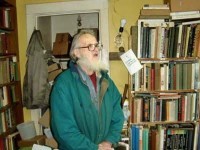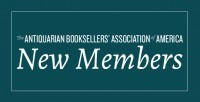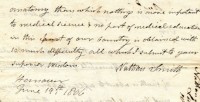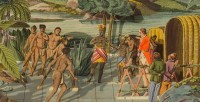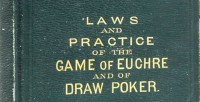The recent news that typeface designer Robert Green -- who produced a digitized version of the classic Doves Type in 2013 -- had recovered over 150 of the original lead punches from the River Thames has caught the imagination of literary and rare-book circles, and spurred many articles on the Doves Press and the visionary book binder and printer Thomas Cobden-Sanderson. What was the Doves Press? In 1900, recovering-lawyer-turned-bookbinder Thomas Cobden-Sanderson founded the Doves Press in partnership with entrepreneur Emery Walker. Both men were part of the Arts & Crafts Movement associated with William Morris, who had earlier founded the Kelmscott Press -- for which Cobden-Sanderson did the binding. While the Kelmscott Press sought to produce the most beautiful and ornate books, the Doves Press strove for elegance and clarity. (I suspect that today, Cobden-Sanderson would design things for Apple). Philip C. Salmon of Bromer Booksellers says, “the thing that defines Cobden-Sanderson is the exacting nature of his craftsmanship, which is very evident in his bindings, and in the very precise nature of his page arrangements.” In pursuit of this clarity and elegance, Walker and Cobden-Sanderson designed a distinctive typeface, now known as “Doves,” in which all their books were set. Among the signature works of the Doves Press are the English Bible (1902-1905) and Paradise Lost (1902). (l) A page from Poems by Keats, Selected and Arranged by Thomas J. Cobden-Sanderson (Do... [more The Doves Press Story]
While in Ireland and out of the book world, I've been posting chapters from a story I'm working on. (See earlier entries on Bookman's Log.) The story is set in the town of Talman, a fictional iteration of Nyack, NY, one of the stops on my book route for decades. One of my favorite dealers in Nyack is Fred Rosselot, a lovely guy with a sharp mind and a sharper eye for books - with which he filled his house. This past weekend, Fred was severely injured in a fire which destroyed his house and his entire stock. For details go to Bookman's Log... Presumably the ABAA Benevolent Fund will be helping out as well. According to colleague Lorne Bair, "I've already forwarded Mr. Rosselot's devastating news to the Trustees, who will no doubt act appropriately." "Of course, there are many on this list who don't donate to the Benevolent Fund, but who might feel moved to donate to Mr. Rosselot directly. Where that's the case, it sounds like under the circumstances he can use every penny that comes his way." "I'll just take this opportunity to point out to all here how clearly this story illustrates the fact that many members of our fraternity/sorority lead a tenuous existence, one step away from disaster. The Benevolent Fund was established in understanding of, and as a partial antidote to, this reality. Give accordingly." "Nuff said. Good luck, Fred! [more Fred Rosselt Injured in House Fire]
The ABAA has recently approved several new members, all of whom have successfully proven themselves to be, in the words of the ABAA Guarantee "established, knowledgeable, and of excellent reputation." These new members were sponsored by existing members, and have undergone a rigorous screening process. We welcome the newest members of the ABAA. FULL MEMBERS: Sammy Blade Berk of Harlan J. Berk, Ltd. Sammy Berk is the head of the Harlan J. Berk, Ltd. Antique Map department. Harlan J. Berk, Ltd. is a family owned and operated business founded in 1964. Today we have a store front in the heart of downtown Chicago, with nearly 20 employees and specialize in a wide array of collectibles, including Ancient Coins, U.S. Coins and Currency, World Coins, Antiquities, Paintings, Antique Maps and Prints. Aside from becoming a new member of the ABAA and ILAB, we are also proud members of the Chicago and Washington Map Society. Harlan J. Berk Ltd. is also the sole organizer of the Chicago International Map Fair, which is held in October. For more information of the map fair, please visit the fair website at www.chicagomapfair.com. Mark Brumberg of Boomerang Booksellers, Northampton, MA Mark started Boomerang Booksellers in 2010 to connect serious readers and collectors with the fine books they cherish and love. Boomerang Booksellers specializes in illustrated books, fine printing, children's books, modern first editions, signed books, & poetry, along with a general selection of antiquarian b... [more New Members: February 2015]
UPDATE (2/19/15): MATERIAL RECOVERED Missing in transit, shipped from San Francisco via US Priority Mail on 2/2/2015, a copy of the Matisse Verve, this copy missing approx. three inches of the binding at the head of the spine. If you are offered this copy or otherwise encounter it, please contact Michael S. Hollander (ABAA) in San Rafael, California, by phone at (415) 572-4224 or mshollbks@gmail.com. [more Missing in Transit: Matisse Verve]
“Nothing is more important to medical science & no part of medical education in this part of the country is obtained with so much difficulty” as the study of anatomy with the use of cadavers. So wrote Dr. Nathan Smith to New Hampshire Governor John Langdon in June 1806. One of the leading medical practitioners and educators of early 19th century America, Smith founded or helped establish four schools of medicine in New England, including those at Dartmouth, Yale, Bowdoin, and the University of Vermont. In the United States, cadavers for anatomy classes were difficult to come by – legally – until at least the 1830s. Anatomical dissection of the human body was viewed with deep suspicion, if not revulsion, especially in New England's clergy-dominated culture. In the early decades of the Republic, traffic in human remains remained largely an underground enterprise involving physicians and body snatchers (or “resurrectionists,” as they were known). Exceptions to the rule might be made, usually in the case of executed criminals whose bodies might be either sold by a creditor or released by the state – which provides the context of Smith's letter. The Nathan Smith letter, page 1 Several weeks before Smith wrote to the Governor, a New Hampshire man named Josiah Burnham had been sentenced to death for the brutal murders of two others. During his sixty-plus years of life, Burnham had worked variously as a whaler, a successful surveyor, and a landowner before becoming invo... [more The Doctor, the Murderer, and the Governor]
The Texas State Library has compiled a list of missing material, including early Texas Republic material and maps missing from its archives. A link to a PDF list of missing material may be found at the Texas State Library website here. This site also includes information on ownership markings and the text of state law on the right of recovery of Texas public records. [more Texas State Archives Missing Materials]
Exhibiting booksellers at the 48th annual California International Antiquarian Book Fair have announced some unusual and notable items that will be for sale at the fair (being held at the Marriott Oakland City Center, Oakland, CA from February 6 to 8, 2015). Some of these special items include: Overdue Bar Tab Invoice for Jimi Hendrix, 1969 “Even the world's greatest rock guitarist can forget to pay his tab once in a while. Hendrix spent a Halloween evening at “The Scene” nightclub in New York in 1969, and apparently, skipped out on his tab. The invoice for $44.25 is from owner Steve Paul stating that “The Scene needs the money badly. Your beverage tab is Past Due.” Hopefully he left a tip!” (Schubertiade Music & Arts LLC, Booth 106, $1,200) The First English Sex Manual from 1684 “Entitled Aristotle's Masterpiece, although not written by Aristotle or a masterpiece, this 17th century primer provides practical advice on copulation, conception, pregnancy and birth. Needless to say, this was an extremely popular book in its time, going through more than 100 editions over two centuries. While not intended as pornography, the graphic nature of the book caused it to be printed and sold “under the table.” One wonders how many teenaged English boys kept a copy hidden under their bed!” (Jeremy Norman HistoryofScience.com, Booth 809, $65,000) Aristotle's Masterpiece Courtesy Jeremy Norman HistoryofScience.com, Booth 809, $65,000 The Heritage Edition of the St. John's... [more CA Book Fair 2015: Featured Items]
In 1868 America you had to pay your bills in America just like you do now. If you were the tidy type, you might have this collapsible pocket bill organizer on your desk. This unusual survival —an expandable pocket bill organizer— was manufactured from gilt-stamped and lettered black cloth (closely matching book cloth seen on publisher's trade bindings for the period) and stiff cardstock. Commercially produced and patented in 1868, think of this as a Victorian office's pre-iPhone utility app. Simply constructed (without any design input from Sir Jonathan Ive), this item functioned as an expanding and collapsible document holder. Each of the bill holder's pockets are indexed for two letters of the alphabet. The index tabs are arranged in pairs. The final pocket, however, held all of those bills indexed for W, X, Y, and Z. (The dreaded bills from Messrs. Z.!) The vertical, top-loading format held bills, receipts, payment vouchers, miscellaneous documents, etc., all secure in each “pocket.” Two cloth bands at the bottom allowed the folder to hinge open while at the same time preventing the holder's contents from spilling out. Another elastic cloth band mounted at the top (not seen here) kept the folder securely closed. Perhaps, this secure closure was optimistically intended to delay bill payment as long as possible. The self-proclaimed Expansive Pocket Bill Holder is gilt-stamped “Novbr. 1868.” The annual report U. S. Commissioner of Patents for 1868¹ notes a patent... [more Paying Your Bills in 1868 America – Expansively]
The ABAA's ever-steady Benevolent Committee, under the auspices of yours truly, will be roaming the aisles at the Oakland Book Fair this coming February 6th-8th, encouraging all to reach deep and channel their inner Carnegies (Andrew, not Dale). As there have been a few last-minute changes, I wanted to take this opportunity to update our readers on the opportunities we'll be providing to contribute to the Benevolent and Woodburn Funds throughout the weekend. First of all, I'll note with sadness that our annual Benefit Poker Tournament, which was a huge success in 2014 and which had been scheduled to take place Thursday night following the Exhibitors' Reception, has been cancelled. It was red tape, not a lack of enthusiasm, that doomed the tournament for this year, and I can promise all you high-rollers that we'll be dealing cards again in Pasadena in 2016. In the meanwhile, I hope all who planned on participating will consider donating their entry fees to the Woodburn Fund, which provides bookseller scholarships to the Rare Book School and the Colorado Antiquarian Book Seminar. Having been personally involved with each of these entities — very personally involved, in the case of CABS — I can attest to the excellent work they do providing continuing education to both novice and experienced members of the antiquarian book trade. One look at the list of ABAA members admitted over the past five years, many of whom have been direct recipients of Woodburn scholarships and many ... [more Tournament Folds, But Giving Still in the Cards]
I've always enjoyed the international nature of the book trade. Buying books from all over the world, and selling them to collectors all over world: what could be better than that? Livres sans frontières. The coming month will see me do just that. This week, I shall be in Stuttgart for the 54th Stuttgarter Antiquariatsmesse. Then, two weeks later, I travel to Oakland for the 48th California International Antiquarian Book Fair. Both fairs will see lots of British booksellers in attendance, whether 'shopping' or as exhibitors. There's always a certain buzz about Stuttgart: the first major fair of the New Year, everyone keen to get hunting to see what they can find. I can remember going to my first Stuttgart fair, back in 1999. In those days, you still had the 'running.' For those who never experienced it, I shall explain. At German book fairs, there is usually a general fair catalogue, which lists details of certain books the various booksellers will be exhibiting at the fair. Importantly, these books must be available when the fair opens: exhibitors are not allowed to sell anything listed in the fair catalogue before the fair. That used to mean that if you really wanted something listed in the fair catalogue, you had to run for it when the fair opened. People would employ young, athletic types (often local students) to run for books. Or you could run yourself. You had to get there early, of course, perhaps an hour before the fair was due to open, to make sure of your place in... [more On Your Marks, Get Set…]



